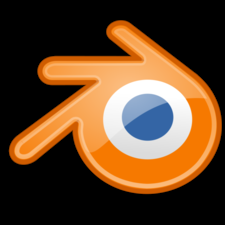Syllabus
General:
The 3D Design Blender course is intended to offer students an introduction to the world of computer generated 3-D modeling. As an introductory course, it provides a basic understanding of the skills and techniques employed by 3-D designers in a wide range of applications. In this online course, we will explore basic mesh modeling, texturing, lighting, animation and rendering. This course should provide a good basis for further independent study in architectural, engineering, game, theatrical and character modeling.
Online:
All of the course material is located on this online course site or is referenced here to other online material. Although all of the instructional material is located on this course site, you must have access to a personal computer on which you can download all of the required Blender software application (free) and execute all of the required assignments.
Personal computer specifications:
General information:
Blender 2.6x works on nearly all operating systems. It runs out of the box, you don't even have to install it. Just unpack the archive you find in the Download section and start Blender.
Graphics card note: Blender runs on all Open GL compliant cards, although there are some issues with cheap onboard cards (Intel, Via).
Operating Systems:
• Windows XP, Vista or 7
• Mac OS X 10.5 and later
• Linux
• FreeBSD
Minimal specs for Hardware:
• 1 GHZ Single Core CPU
• 512 MB RAM • 1024 x 768 px Display with 16 bit color
• 3 Button Mouse
• Open GL Graphics Card with 64 MB RAM
Good specs for Hardware:
• 2 GHZ Dual Core CPU
• 2 GB RAM • 1920 x 1200 px Display with 24 bit color
• 3 Button Mouse
• Open GL Graphics Card with 256 or 512 MB RAM Production specs for Hardware
• 64 bits, Multi Core CPU
• 8-16 GB RAM
• Two times 1920 x 1200 px Display with 24 bit color
• 3 Button Mouse + tablet
• Open GL Graphics Card with 1 GB RAM, ATI FireGL or Nvidia Quadro (3 Button Mouse
Note: You must have a 3-Button mouse. Blender uses 3 buttons on the mouse to navigate the 3-D space and edit objects. Ideally your 3-Button mouse will have a center scroll wheel. Although Blender will work with other mouse arrangements, all of the video and PDF tutorials in this course reference the use of a 3-button mouse.
Installation Windows OS:
The download .zip contains a Blender folder. You may put this anywhere on your hard drive. To launch Blender, double-click on Blender.exe. Install scripts by putting them in the .blender/scripts folder next to the executable.
Installation Mac OS X:
The downloaded package includes blender.app. Optionally copy this to your Applications folder, and add it to the dock by dragging it from there to the dock. Install scripts by putting them in the .blender/scripts inside your home folder. If the folder does not exist, you can create it manual.
Note: A step-by-step installation guide for Blender can be found in the suggested textbook for this course (How to Get Blender - pages xii - xv) John Blain - The Complete Guide to Blender Graphics
Course Structure:
Lessons:
There are series of learning units called "Lessons". These lessons contain video tutorials, PDF tutorials, exercises and other suggested learning materials.
The Blender software, as you will discover, is quite complex. It is by no means intuitive and the hardest part of learning it is getting used to the interface. The material becomes progressively harder so it is important that you keep up with the learning units.
Video Tutorials:
Each lesson contains a series of video tutorials. The video tutorials can simply be viewed (however you may want to try some of the techniques in the Blender software yourself).
PDF Tutorials:
Each lesson contains at least one PDF tutorial. These tutorials are quite detailed, especially in the first few lessons, so that you can follow a step-by-step modeling process. Later PDF tutorials are less detailed as you should, by then, be familiar with many of the Blender tools. The PDF tutorials should be worked through with a copy of Blender open executing all of the directions.
Exercises:
Each Lesson has an accompanying exercise. This is to test your comprehension of the video tutorials and lead you to exploring some of the Blender tools on your own. You can also view all of the Exercises by clicking on the "Materials" tab.
Textbook:
The suggested textbook readings are from John Blain’s “The Complete Guide to Blender Graphics (Computer Modeling and Animation)”. You can purchase this textbook from a variety of book stores including Amazon.com
Projects:
There a number of suggested projects designed to integrate the modeling, texturing and animation skills you are learning with your own imagination and self-expression. These projects, over time, will allow you to develop your own creative process for realizing your 3d designs and animations. There are 8 projects divided into 4 groups (Project 1A, Project 1B, Project 2A etc.).
I suggest that you execute one of the Project #1 projects after completing the first 5 lessons; one of the project #2 projects after completing the first 8 lessons; one of the Project #3 projects after completing the first 10 lessons and one of the Project #4 projects after completing lesson #12.
Taking an Online Course:
Taking an online course can be both a blessing and a curse. On one hand, it allows you to work on your own time schedule. On the other hand, there are no scheduled classes to keep your focus on the subject. The workload of video and PDF tutorials is very large, especially during the first 5 lessons. It is very easy to fall behind or to put it off for latter. Online classes require a great deal of self-discipline and self-motivation. I strongly urge you to set aside a specific time period each week to work on the learning units, exercises and projects.
Neal Hirsig
Tufts University

